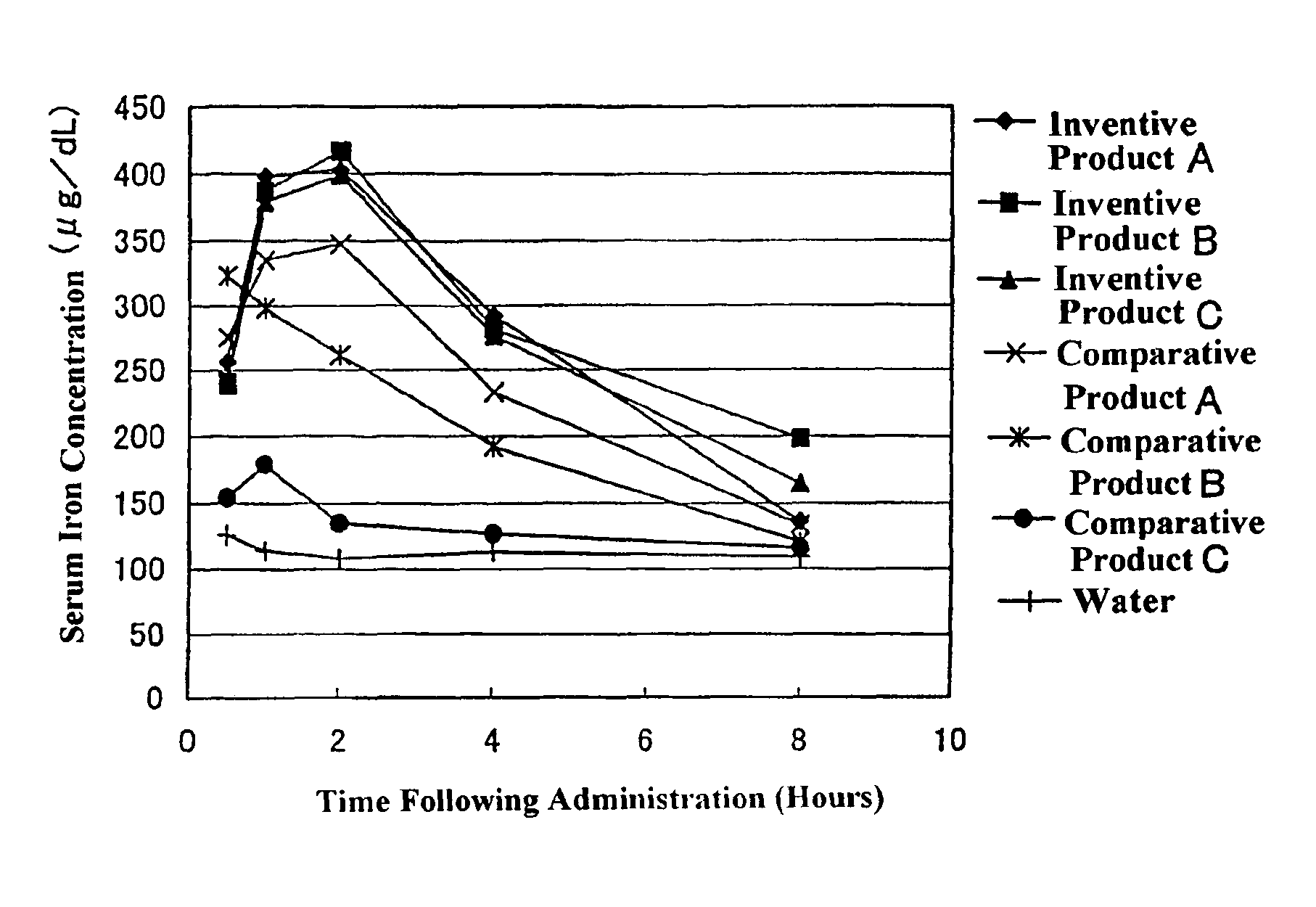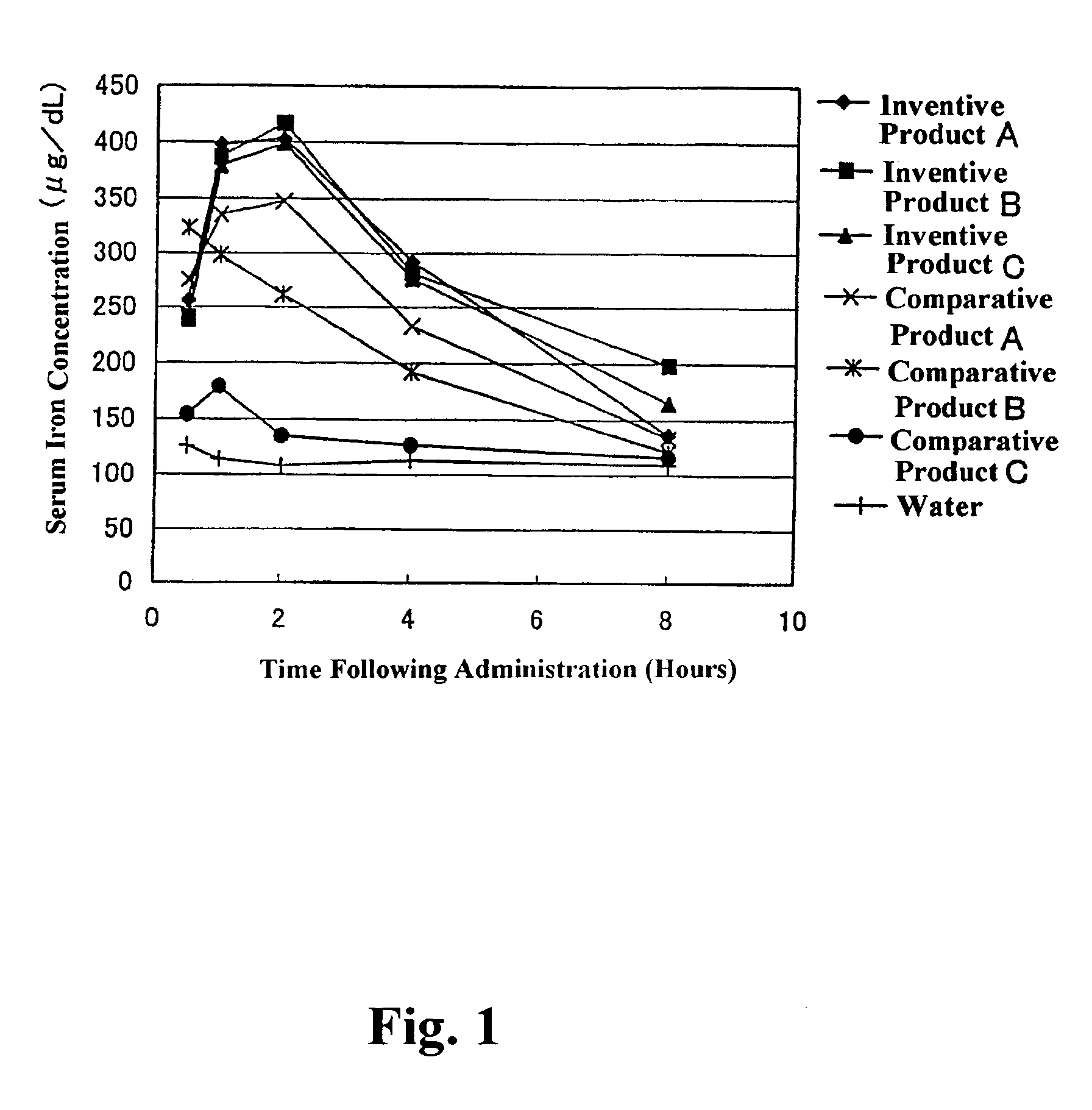Mineral composition
a technology of mineral composition and mineral oil, which is applied in the field of mineral composition, can solve the problems of insufficient mineral intake, insufficient intake, and major problems of osteoporosis, which is a bone deterioration disease, and achieves excellent bioabsorption, no influence on taste, color, physical properties,
- Summary
- Abstract
- Description
- Claims
- Application Information
AI Technical Summary
Benefits of technology
Problems solved by technology
Method used
Image
Examples
example 1
[0076]A dispersion prepared by dispersing 4 kg of ferric pyrophosphate (manufactured by Tomita Yakuhin Kogyo K. K.) in 94.9 kg of deionized water was placed in a Dyno-Mill, and the particles of ferric pyrophosphate were physically ground, to prepare a slurry containing the ground particles having an average particle size of about 0.25 μm. To the slurry was added and dissolved therein 1.1 kg of diglycerol monolaurate (trade name: “SUNSOFT Q-12 D”; HLB=9; monoester content: 80% by weight; specific gravity: 0.9; manufactured by Taiyo Kagaku Co., Ltd.). The solution was heated until the temperature thereof was 45° C., and then subjected to a treatment in a homogenizer for 15 minutes. Thereafter, the temperature of the solution was further increased to 75° C., and then kept at 75° C. for 10 minutes. Following the above procedure, a ferric pyrophosphate dispersion composition having a solid content of 4% by weight (Inventive Product A) was obtained (average particle size of fine metal par...
example 2
[0077]A dispersion prepared by dispersing 4 kg of ferric pyrophosphate (manufactured by Tomita Yakuhin Kogyo K. K.) in 93 kg of deionized water was placed in a Dyno-Mill, and the particles of ferric pyrophosphate were physically ground, to prepare a slurry containing the ground particles having an average particle size of about 0.25 μm. To the slurry was added and dissolved therein an emulsion agent preparation prepared by mixing and dissolving in 1.7 kg of deionized water previously heated to 65° C. 1.2 kg of diglycerol monomyristate (trade name: “SUNSOFT Q-14 D”; HLB=8.3, monoester content: 75% by weight; specific gravity: 0.9; manufactured by Taiyo Kagaku Co., Ltd.) and 0.1 kg of pentaglycerol monolaurate (A-121E; HLB=13; specific gravity: 0.9; manufactured by Taiyo Kagaku Co., Ltd.). The solution was heated until the temperature thereof was 45° C., and then subjected to a treatment in a homogenizer for 15 minutes. Thereafter, the temperature of the solution was further increased...
example 3
[0078]In 60 kg of ion-exchanged water was dissolved 13 kg of ferric chloride hexahydrate to prepare an iron solution. To a solution prepared by dissolving 20 kg of tetrasodium pyrophosphate decahydrate in 500 kg of ion-exchanged water was gradually added the above iron solution with stirring. The pH of the resulting mixture was adjusted to 3 using a handy pH meter manufactured by HORIBA, Ltd. After forming of the salt of ferric pyrophosphate by neutralization reaction was terminated, the resulting reaction mixture was subjected to solid-liquid separation by centrifugation (3000×g, for 5 minutes), and ferric pyrophosphate of the solid phase portion was collected. The ferric pyrophosphate was resuspended in ion-exchanged water, to give a slurry containing particles (average particle size: about 0.21 μm) of ferric pyrophosphate with a solid content of 4% by weight. Fifty kilograms of the slurry was transferred to another stainless beaker, and 0.8 kg of diglycerol monopalmitate (HLB=7.3...
PUM
| Property | Measurement | Unit |
|---|---|---|
| particle size | aaaaa | aaaaa |
| specific gravity | aaaaa | aaaaa |
| specific gravity | aaaaa | aaaaa |
Abstract
Description
Claims
Application Information
 Login to View More
Login to View More - R&D
- Intellectual Property
- Life Sciences
- Materials
- Tech Scout
- Unparalleled Data Quality
- Higher Quality Content
- 60% Fewer Hallucinations
Browse by: Latest US Patents, China's latest patents, Technical Efficacy Thesaurus, Application Domain, Technology Topic, Popular Technical Reports.
© 2025 PatSnap. All rights reserved.Legal|Privacy policy|Modern Slavery Act Transparency Statement|Sitemap|About US| Contact US: help@patsnap.com



